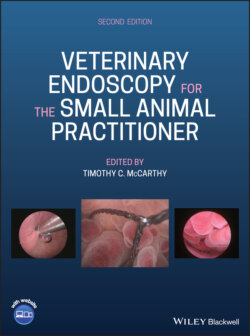Читать книгу Veterinary Endoscopy for the Small Animal Practitioner - Группа авторов - Страница 20
2.1 Endoscopy Room Setup and Organization
ОглавлениеDedicated endoscopy and operating rooms greatly facilitate performing diagnostic endoscopy and minimally invasive surgery. Having all the equipment setup, organized, and ready to use will have a major impact on the frequency of endoscope use in a busy practice. If getting everything ready is time consuming and difficult, endoscopy will not be performed and everything will get done the old way. Patients will not benefit from the advantages of minimally invasive diagnostic or operative procedures if it is too inconvenient to get the equipment ready. In addition to lack of patient benefit, the practice will also fail to benefit from the purchase of the equipment both from a financial standpoint and improved staff satisfaction in being able to provide better medical care.
This concept also applies to employee training. If the staff is not comfortable with turning on and operating the complex array of equipment required for endoscopy, there will be resistance to use it. With staff resistance to endoscope use, there will be no use and the equipment will be in the way while collecting dust.
If dedicated rooms are not available, specific areas of existing multiuse rooms providing a space for the equipment, adequate room for performing procedures, and suitable environmental conditions to support the needs of the procedures are essential. A room with a large window that cannot be covered does not provide the darkened conditions needed for adequate visibility of video monitors. A room without windows or with small windows that can be covered is a much better choice. A room with high traffic flow is not ideal and an out of the way room with only one entrance is a preferable option. Adequate space is also a must, particularly for an operating room where sterile technique is required. Adding an endoscopy tower to an operating room that is already too small will not provide an optimum surgical environment.
When performing diagnostic endoscopy or minimally invasive surgery, it is vitally important to be able to organize the patient, the endoscopy tower, an anesthetic machine, monitors, an instrument table, and with adequate room for the endoscopists or surgeon and supporting staff to work. Endoscopy towers are typically on wheels so that they can be moved easily for room setup to accommodate positioning for different procedures. Anesthesia machines and instrument tables are also commonly on wheels allowing them to be easily arranged. Many surgery tables do not have wheels, are heavy, and difficult to move. Purchasing a surgery table that is on wheels or adding wheels to an existing surgery table will make everything much easier. Easier is the key to increasing the frequency of endoscopy and minimally invasive surgery procedures.
Monitor placement is critical to all forms of endoscopy. Arranging the monitor so that the endoscope, rigid or flexible, is pointed at the monitor during the procedure will make orientation and manipulations much easier. The more endoscope and monitor position deviates from this ideal, the greater the difficulty in performing procedures. This is particularly true for beginners. Most diagnostic and operative procedures are performed with one monitor on the endoscopy tower, but other procedures require a second monitor or require movement of the patient or monitor during procedures. With the ready availability of inexpensive flat screen monitors, adding a second monitor to operating rooms used for minimally invasive surgery is beneficial. Wireless transmission systems for video signals are also inexpensive and make adding a second monitor simple and easy. A wall‐mounted second monitor minimizes the amount of space needed.
